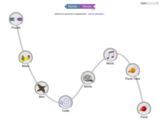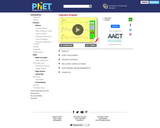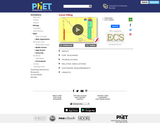
Help early education students explore simple block coding through interactive games.
- Subject:
- Career and Technical Education
- Material Type:
- Simulation
- Provider:
- Provider Set:
- Google for Education
- Author:
- Date Added:
- 08/30/2021

Help early education students explore simple block coding through interactive games.

Bug Hunt uses NetLogo software and simulates an insect population that is preyed on by birds. There are six speeds of bugs from slow to fast and the bird tries to catch as many insects as possible in a certain amount of time. Students are able to see the results graphed as the average insect speed over time, the current bug population and the number of insects caught. There are two variations to try for the predator, one where the predator pursues the prey and one where the predator stays still and captures insects that pass nearby. In the first case the bird catches the slow insects and the faster ones survive, reproduce and pass genes on. The average speed of bug should increase over time. In the second case the faster bugs come near to the bird more often than the slow ones. The slow ones survive more, reproduce and pass their genes on.

Build fractions from shapes and numbers to earn stars in this fractions game or explore in the Fractions Lab. Challenge yourself on any level you like. Try to collect lots of stars!

Build fractions from shapes and numbers to earn stars in this fractions game or explore in the Fractions Lab. Challenge yourself on any level you like. Try to collect lots of stars!

When will objects float and when will they sink? Learn how buoyancy works with blocks. Arrows show the applied forces, and you can modify the properties of the blocks and the fluid.

When will objects float and when will they sink? Learn how buoyancy works with blocks. Arrows show the applied forces, and you can modify the properties of the blocks and the fluid.

Draw a graph of any function and see graphs of its derivative and integral. Don't forget to use the magnify/demagnify controls on the y-axis to adjust the scale.

Draw a graph of any function and see graphs of its derivative and integral. Don't forget to use the magnify/demagnify controls on the y-axis to adjust the scale.

Camera simulators for photography instructors and their students.

Water is a limited resource that we use over and over again. The idea is to teach the science behind the water cycle, where water comes from and is located on the Earth. After research and developing and understanding of conservation students will create a water tower that will collect and store rainwater. Students will also create a Public Service Announcement (PSA) on water conservation.

Play with the camera controls found in the 'Creative Zone' of an EOS Digital SLR. Here, you can really dictate the outcome of your photos and get the effects you want. Your shots will appear below where you can review, get feedback and compare the settings you used.

Explore how a capacitor works! Change the size of the plates and add a dielectric to see how it affects capacitance. Change the voltage and see charges built up on the plates. Shows the electric field in the capacitor. Measure voltage and electric field.

Move point charges around on the playing field and then view the electric field, voltages, equipotential lines, and more. It's colorful, it's dynamic, it's free.

This new version of the CCK adds capacitors, inductors and AC voltage sources to your toolbox! Now you can graph the current and voltage as a function of time.

Build circuits with capacitors, inductors, resistors and AC or DC voltage sources, and inspect them using lab instruments such as voltmeters and ammeters.

Build circuits with resistors, light bulbs, batteries, and switches and take measurements with laboratory equipment like the realistic ammeter and voltmeter.

CircuitLab is an online platform for designing and simulating both analog and digital circuits directly in a web browser. It features an intuitive schematic editor and powerful simulation tools, making it suitable for students, hobbyists, and professional engineers. The platform supports professional-quality schematics and wiring diagrams without requiring any installation.

Experiment with conductivity in metals, plastics and photoconductors. See why metals conduct and plastics don't, and why some materials conduct only when you shine a flashlight on them.

Experiment with conductivity in metals, plastics and photoconductors. See why metals conduct and plastics don't, and why some materials conduct only when you shine a flashlight on them.

With your mouse, drag data points and their error bars, and watch the best-fit polynomial curve update instantly. You choose the type of fit: linear, quadratic, cubic, or quartic. The reduced chi-square statistic shows you when the fit is good. Or you can try to find the best fit by manually adjusting fit parameters.